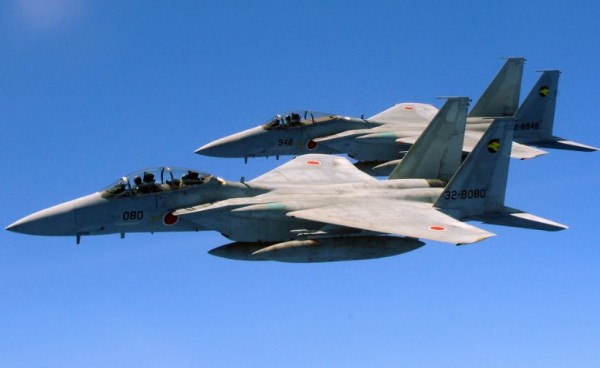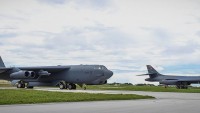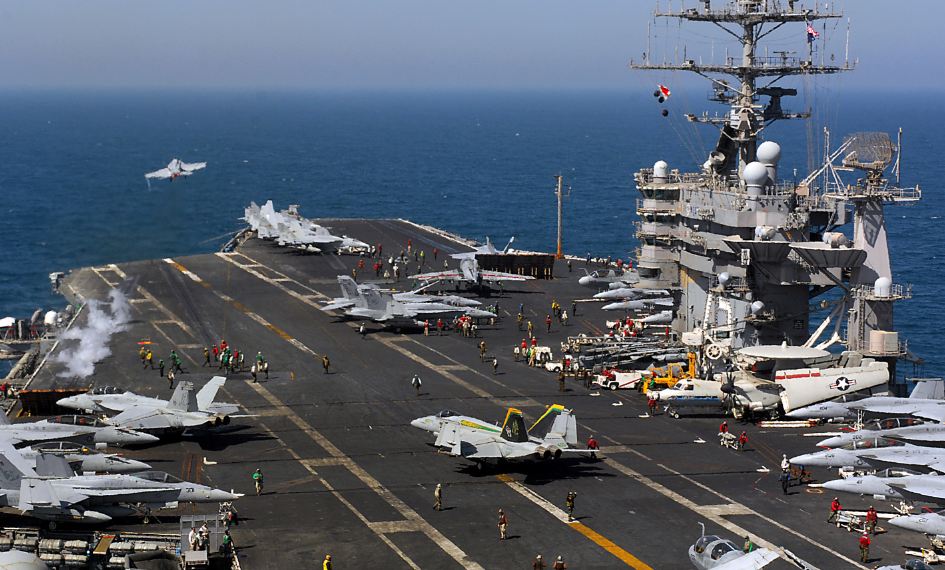Japan’s Record 2017 Defense Budget Prepares for Conflict against China and North Korea
| Arthur Dominic Villasanta | | Aug 22, 2016 10:02 AM EDT |
(Photo : Japan Air Self-Defense Force ) Japan Air Self-Defense Force F-15Js.
Japan's Ministry of Defense is asking for a record budget of $51 billion for fiscal 2017 to cope with persistent military threats from China and North Korea amid growing tensions that might spin out of control.
Like Us on Facebook
The defense budget is the fifth successive annual increase and is 2.3 percent higher than the current budget. Of this amount, $927 million will go to upgrading the PAC-3 variant of the MIM-104 Patriot surface-to-air missile (SAM) system manufactured by U.S. defense contractor Raytheon.
PAC-3 is a significant upgrade to nearly every aspect of the Patriot system. The new upgrade will double the range of the PAC-3's missile to more than 30 kilometers.
Japan will also set aside funds to produce the Block IIA version of RIM-161 Standard Missile 3 (SM-3) being jointly developed with the United States to shoot down missiles at high altitudes. SM-3 is a ship-based missile system used to intercept short-to intermediate-range ballistic missiles as a part of Aegis Ballistic Missile Defense System.
Funds will also be allotted to acquire the Lockheed Martin F-35A Lightning II stealth fighter jet. Japan has ordered 48 of the fifth generation stealth fighter and is one of eight countries jointly developing this aircraft.
Pilots of the Japan Air Self-Defense Force will fly the F-35A fighter jet for the first time by year end. The first four F-35s earmarked for Japan will roll off a production line in Fort Worth, Texas in November. The F-35s will be stationed at the Misawa Air Base alongside U.S. F-16s from the 35th Fighter Wing.
Funds will also go to strengthening Japan Coast Guard installations in the southern islands of Miyakojima and Amami Oshima to counter China's increasingly brazen aggression in the East China Sea.
Japan last June warned China further Chinese military naval incursions in the waters off its Senkaku islands that China also claims will compel Japan to take "necessary actions," including mobilizing the Japan Maritime Self-Defense Force (JMSDF). The warning was prompted by a warship of the People's Liberation Army Navy (PLAN) entering waters just outside Japanese territorial waters around the Senkakus.
Analysts have taken this to mean Japan has drawn a clear red line with the warning that violations of Japanese sovereignty by the PLAN will be met by force.
China has since tested this red line by sending PLAN warships close to the Senkakus but not close enough to trigger a Japanese military response. In its most blatant challenge to Japan, China last Aug. 6 sent a fleet of 230 fishing boats protected by seven China Coast Guard ships to swarm the waters off the Senkakus. Japan lodged a strong diplomatic protest over the Chinese provocation.
TagsJapan, Ministry of Defense, china, North Korea, PAC-3 variant, RIM-161 Standard Missile 3, F-35A Lightning II
©2015 Chinatopix All rights reserved. Do not reproduce without permission
EDITOR'S PICKS
-

Did the Trump administration just announce plans for a trade war with ‘hostile’ China and Russia?
-

US Senate passes Taiwan travel bill slammed by China
-

As Yan Sihong’s family grieves, here are other Chinese students who went missing abroad. Some have never been found
-

Beijing blasts Western critics who ‘smear China’ with the term sharp power
-

China Envoy Seeks to Defuse Tensions With U.S. as a Trade War Brews
-

Singapore's Deputy PM Provides Bitcoin Vote of Confidence Amid China's Blanket Bans
-

China warns investors over risks in overseas virtual currency trading
-

Chinese government most trustworthy: survey
-

Kashima Antlers On Course For Back-To-Back Titles
MOST POPULAR
LATEST NEWS
Zhou Yongkang: China's Former Security Chief Sentenced to Life in Prison

China's former Chief of the Ministry of Public Security, Zhou Yongkang, has been given a life sentence after he was found guilty of abusing his office, bribery and deliberately ... Full Article
TRENDING STORY

China Pork Prices Expected to Stabilize As The Supplies Recover

Elephone P9000 Smartphone is now on Sale on Amazon India

There's a Big Chance Cliffhangers Won't Still Be Resolved When Grey's Anatomy Season 13 Returns

Supreme Court Ruled on Samsung vs Apple Dispute for Patent Infringement

Microsoft Surface Pro 5 Rumors and Release Date: What is the Latest?













